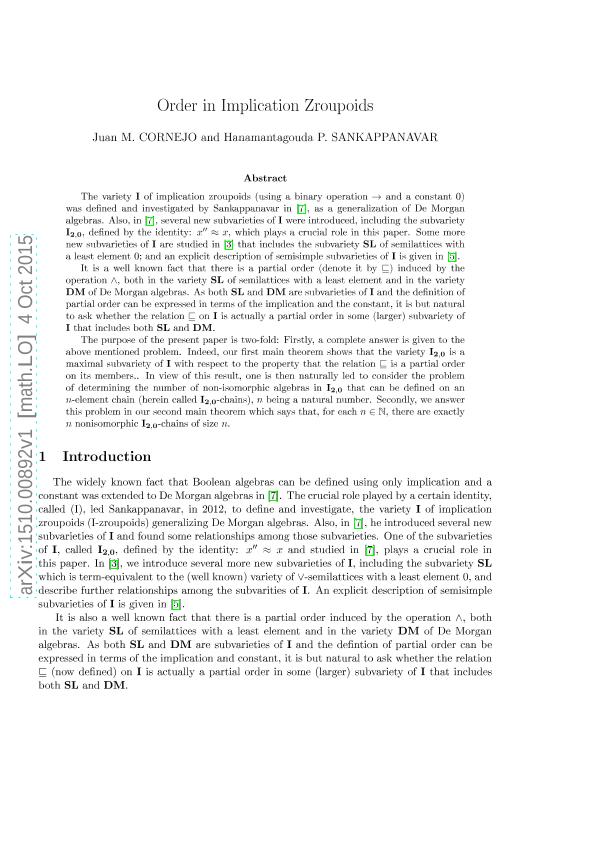Mostrar el registro sencillo del ítem
dc.contributor.author
Cornejo, Juan Manuel

dc.contributor.author
Sankappanavar, Hanamantagouda P.

dc.date.available
2018-09-21T23:18:14Z
dc.date.issued
2016-06
dc.identifier.citation
Cornejo, Juan Manuel; Sankappanavar, Hanamantagouda P.; Order in Implication Zroupoids; Springer; Studia Logica; 104; 3; 6-2016; 417-453
dc.identifier.issn
0039-3215
dc.identifier.uri
http://hdl.handle.net/11336/60695
dc.description.abstract
The variety I of implication zroupoids (using a binary operation → and a constant 0) was defined and investigated by Sankappanavar (Scientia Mathematica Japonica 75(1):21–50, 2012), as a generalization of De Morgan algebras. Also, in Sankappanavar (Scientia Mathematica Japonica 75(1):21–50, 2012), several subvarieties of I were introduced, including the subvariety I2 ,0, defined by the identity: x″≈ x, which plays a crucial role in this paper. Some more new subvarieties of I are studied in Cornejo and Sankappanavar (Algebra Univ, 2015) that includes the subvariety SL of semilattices with a least element 0. An explicit description of semisimple subvarieties of I is given in Cornejo and Sankappanavar (Soft Computing, 2015). It is a well known fact that there is a partial order (denote it by ⊑) induced by the operation ∧, both in the variety SL of semilattices with a least element and in the variety DM of De Morgan algebras. As both SL and DM are subvarieties of I and the definition of partial order can be expressed in terms of the implication and the constant, it is but natural to ask whether the relation ⊑ on I is actually a partial order in some (larger) subvariety of I that includes both SL and DM. The purpose of the present paper is two-fold: Firstly, a complete answer is given to the above mentioned problem. Indeed, our first main theorem shows that the variety I2,0 is a maximal subvariety of I with respect to the property that the relation ⊑ is a partial order on its members. In view of this result, one is then naturally led to consider the problem of determining the number of non-isomorphic algebras in I2,0 that can be defined on an n-element chain (herein called I2,0-chains), n being a natural number. Secondly, we answer this problem in our second main theorem which says that, for each n∈ N, there are exactly n nonisomorphic I2, 0-chains of size n.
dc.format
application/pdf
dc.language.iso
eng
dc.publisher
Springer

dc.rights
info:eu-repo/semantics/openAccess
dc.rights.uri
https://creativecommons.org/licenses/by-nc-nd/2.5/ar/
dc.subject
Boolean Algebra
dc.subject
De Morgan Algebra
dc.subject
Finite I2 , 0-Chain
dc.subject
Implication Zroupoid
dc.subject
Partial Order
dc.subject
The Variety I2 , 0
dc.subject.classification
Matemática Pura

dc.subject.classification
Matemáticas

dc.subject.classification
CIENCIAS NATURALES Y EXACTAS

dc.title
Order in Implication Zroupoids
dc.type
info:eu-repo/semantics/article
dc.type
info:ar-repo/semantics/artículo
dc.type
info:eu-repo/semantics/publishedVersion
dc.date.updated
2018-09-18T14:23:37Z
dc.identifier.eissn
1572-8730
dc.journal.volume
104
dc.journal.number
3
dc.journal.pagination
417-453
dc.journal.pais
Alemania

dc.journal.ciudad
Berlín
dc.description.fil
Fil: Cornejo, Juan Manuel. Consejo Nacional de Investigaciones Científicas y Técnicas. Centro Científico Tecnológico Conicet - Bahía Blanca. Instituto de Matemática Bahía Blanca. Universidad Nacional del Sur. Departamento de Matemática. Instituto de Matemática Bahía Blanca; Argentina
dc.description.fil
Fil: Sankappanavar, Hanamantagouda P.. State University of New York; Estados Unidos
dc.journal.title
Studia Logica

dc.relation.alternativeid
info:eu-repo/semantics/altIdentifier/url/https://link.springer.com/article/10.1007/s11225-015-9646-8
dc.relation.alternativeid
info:eu-repo/semantics/altIdentifier/doi/http://dx.doi.org/10.1007/s11225-015-9646-8
dc.relation.alternativeid
info:eu-repo/semantics/altIdentifier/url/https://arxiv.org/abs/1510.00892
Archivos asociados
